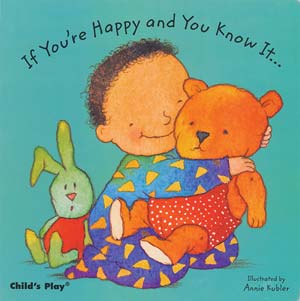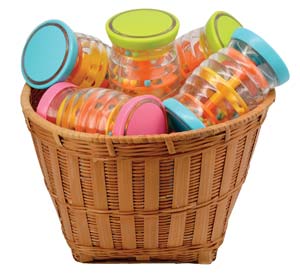Receptive language, Expressive language
Toddlers participate in a book sharing focused on different ways a young child shows he/she is happy.



 [Invite several toddlers to join you to look at pictures of being happy.]
[Invite several toddlers to join you to look at pictures of being happy.]
Sometimes we have a big smile when we feel happy. Let’s all show a big smile.
[Demonstrate a smile while pointing to your mouth. Encourage toddlers to smile.]
There are different ways to show we feel happy.
[Show the cover of the book and point to the baby.]
The baby in this picture is happy. What is the baby doing?
[Pause for toddler responses. Repeat and expand responses.
Emphasize the baby is smiling and hugging a teddy bear.]
We can smile and hug a teddy bear when we are happy. The pictures in our book tell us more things to do when we are happy. Let’s look inside our book.
[Use the following strategies to describe pictures in the book:
If time or toddler interest is limited, focus on pictures that you anticipate will be of greater interest to toddlers. You may wish to omit the “hold on tight” page.]
The pictures in our book showed us different things we can do when we are happy. Smiling is one way to show we are happy. There are many more ways to show we are happy!
The book featured in this activity plan extends the attention to feelings offered in recent and current Social-Emotional activity plans. Toddlers’ familiarity with happy is a useful base for strengthening awareness of new words and phrases. In particular, monitor each toddler’s reaction to your descriptions of action words included in the book text and corresponding pictures. Some words or phrases may not be familiar to some toddlers in the contexts in which they are used in the book. Example: The “push the blocks” phrase may be new to a toddler who thinks of the action as “knocking over” a tower of blocks. Look for opportunities to help a toddler learn that the same action can be described in different ways.
Extra support
Enrichment
Receptive language, Expressive language
Toddlers briefly act out ways of showing we are happy as part of a book sharing.



 Share the book with several toddlers using the strategies suggested in Option 1. Emphasize the pictures show some things the baby does when he/she is happy. At the conclusion of the book, return to pictures that seemed to be of particular interest to toddlers. Use the following steps to strengthen awareness of words or phrases:
Share the book with several toddlers using the strategies suggested in Option 1. Emphasize the pictures show some things the baby does when he/she is happy. At the conclusion of the book, return to pictures that seemed to be of particular interest to toddlers. Use the following steps to strengthen awareness of words or phrases:
Doing an action associated with a word or phrase is a valuable way to strengthen understanding of the word or phrase. Saying a key word is also beneficial for language development. Some toddlers may prefer to watch and listen rather than talk and act. Remember that watching and listening are useful ways to learn, and positively acknowledge different forms of participation.
Extra support
Enrichment
 Materials Needed: If You’re Happy and You Know It… by Annie Kubler, If You’re Happy and You Know It (A Barefoot Singalong) by Anna McQuinn, several shakers or rattles in a basket
Materials Needed: If You’re Happy and You Know It… by Annie Kubler, If You’re Happy and You Know It (A Barefoot Singalong) by Anna McQuinn, several shakers or rattles in a basket
Place the books and the basket of shakers/rattles on a blanket on the floor. Invite several toddlers to use the shakers/rattles as they look at pictures in the books. Some toddlers may act out some of the pictures with your guidance, and others may say some words, such as “baby” or “clap.” Read or sing some of the pages in the books and join toddlers in moving a shaker or rattle during the song.
Materials Needed: If You’re Happy and You Know It (A Barefoot Singalong) by Anna McQuinn
Invite all children in your setting to read the book with you and sing this popular song. Invite children to imitate the actions of some of the pictured children. After the book reading, invite each toddler and preschool-age child to do an action of their choice during a verse of the song. Older children may wish to participate too, and perhaps demonstrate some actions. Infants may enjoy being held, and older infants may engage in clapping or reaching up high.